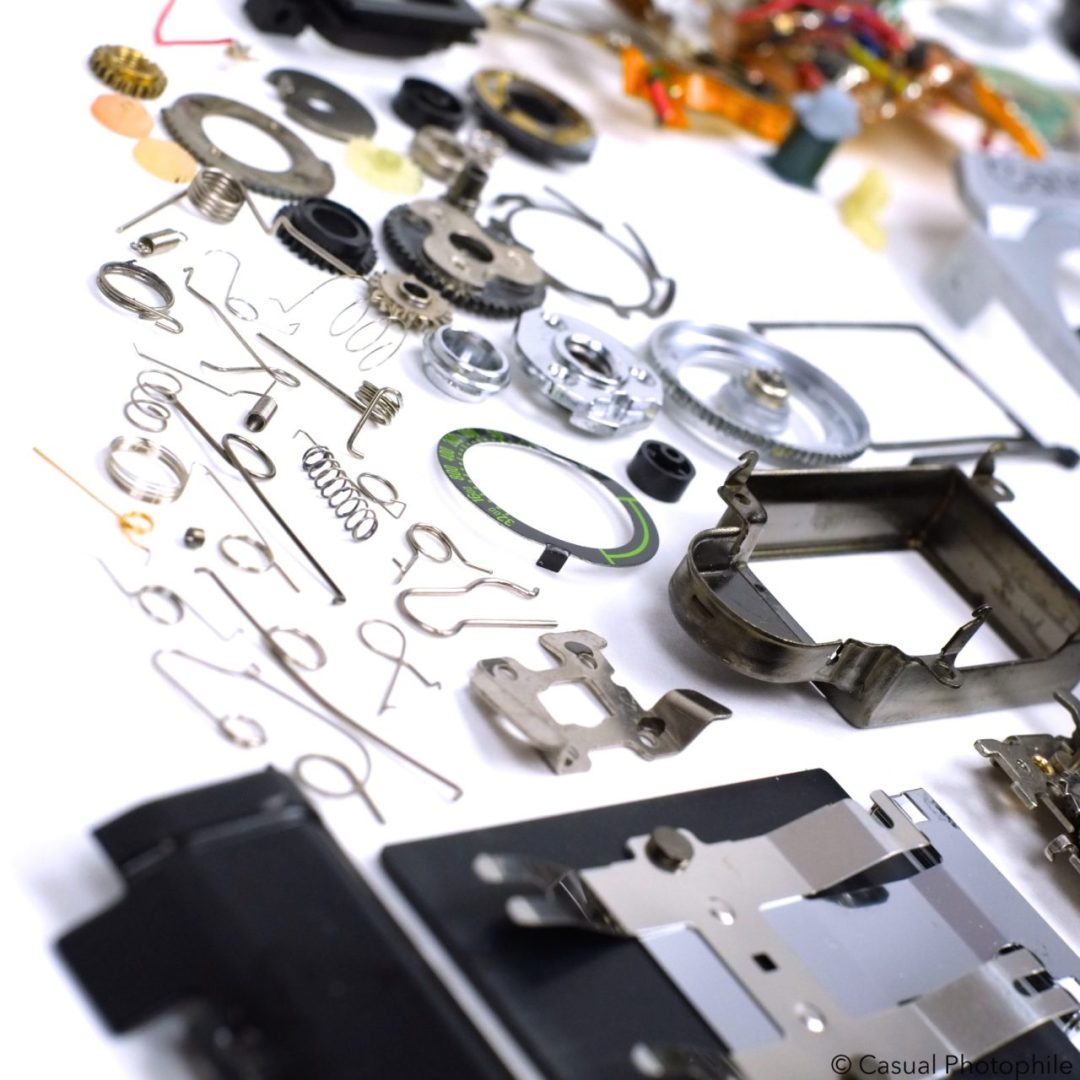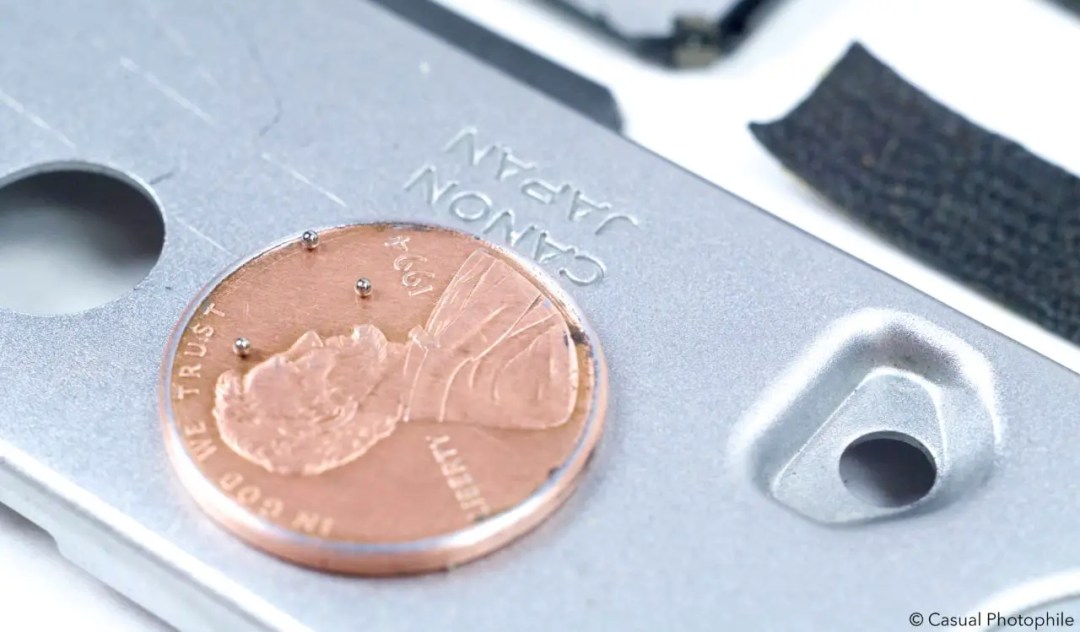Casual Photophile was born from an appreciation that cameras are amazing, tiny machines. What better way to illustrate the intricacy and wonder of these little devices than to tear them apart and splay their innards across a cold, white slab?
I’m always looking for new ways to bring unique content to my readers, and today I’m starting a new segment that delves into the nuts and bolts of vintage cameras – literally. I’m calling it Exploded Views, and every few weeks I’ll show you every spring, gear, lever, and screw that make up a particular camera. For my first exploded view, I’ve torn apart one of the most iconic classic cameras, the Canon AE-1.
Check it out.
Many blisters were formed taking this little camera down to its individual pieces. Let’s look at some of the interesting mechanisms I found along the way. The first thing one will notice is the sheer number of components. This thing has an unbelievable number of springs, gears, screws, etc., and they’re all incredibly tiny.
That’s the tripod mount seen below and to the right. Somewhat of a course casting, if I’m being honest. The internal gears, however, are very finely tuned. It’s interesting to see such a mix of materials for use in gears. Though it should be expected; many publications at the time of this camera’s release bemoaned Canon’s decision to opt for plastic internals.
Material aside, seeing the camera broken down into its individual components really helps us appreciate the remarkable miracle of engineering that’s springing to life in our hands every time we shoot a photo.



The springs visible in the above shot are exceedingly fine, small, and delicate. Some of them are virtually weightless, and it’s difficult to imagine the process that created them. But even though they seem insignificant, they’re used universally throughout the camera for a vast number of operations, most notably in the mirror-box assembly.
Below I’ve placed the same springs next to a U.S. Penny to give a sense of scale.
Similarly numerous are the many varieties of retaining clips used to secure gears, levers, and actuators. Some of these cir-clips and retainers, again seen below, are no larger than a pin-head. Amazing.
Even further along we find an assortment of parts responsible for the many mechanical actions that take place in the AE-1. Notable among these is an assembly in the upper right of a following shot is a riveted assembly of gears and levers. This assembly is housed on the side of the mirror-box and, with some hand-actuation, it’s pretty clear that this is the major offender in cases of the infamous “Canon Squeel”.




Some of the electronic circuitry is pictured above. This was arguably the most important component of the AE-1, and essentially launched an entirely new generation of electronically controlled cameras. One of the first cameras to use this type of technology, the AE-1 propelled the industry forward on a wave of progressive computerization that would continue for decades.
We can also see the camera’s top plate, electro-plated plastic as opposed to metal. This was just one of many cost-saving measures that helped Canon become one of the most fiscally successful camera-makers of the era.
Below we have a veritable forest of screws and bolts. Merely one segment of the whole collection, this makes up roughly one-third the entire count of fasteners. Notice the different materials used for different applications, including brass, chromed machine screws, and hardened steel.
Further below I’ve shown the lens-mount bezel and nameplate, and a detail shot of the internal viewfinder surround. Notice the aperture display in all its analog glory. Exceedingly minute. And further on we see the pentaprism.
Finally, one of the most astounding discoveries made while dissembling the Canon AE-1, within a certain gear there rested a vast number of the smallest steel ball bearings I’ve ever seen. So tiny were they that I had to display them in relation to something similarly small. A few of the bearings rest on a U.S. Penny, which lies next to an engraving on the bottom plate of the AE-1.




And that’s what a Canon AE-1 looks like after three nights of disassembly. I hope you’ve enjoyed checking out the guts of one of the most iconic vintage cameras ever made. If you want to see more, let me know in the comments. And if you’re in love with a certain camera and want to know what it looks like on the inside, let me know about it.
Prints of this entire series, including the amazing F3 Exploded View print, are available to purchase through my camera shop and via Etsy.
Buy the Print
Want your own Canon AE-1?
Buy it at F Stop Cameras
Buy it on eBay
Buy it on Amazon
Shop B&H Photo’s vintage gear
Follow Casual Photophile on Facebook and Instagram
[Some of the links in this article will direct users to our affiliates at B&H Photo, Amazon, and eBay. By purchasing anything using these links, Casual Photophile may receive a small commission at no additional charge to you. This helps Casual Photophile produce the content we produce. Many thanks for your support.]




Truly amazing. Sure the act of photographing can be so straight and clean (shutter, focus and aperture) that hides the vast complexity of its mechanism inside an elegant body. I was amazed, and surpassed, when I attempted to repair my Canon EF and saw so many elements.